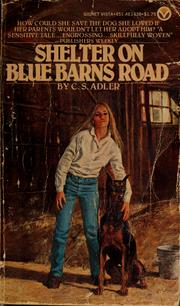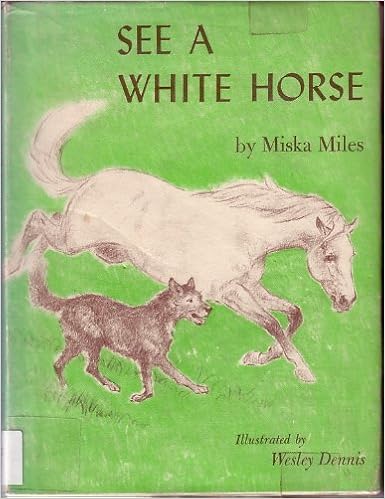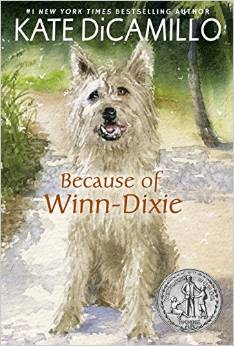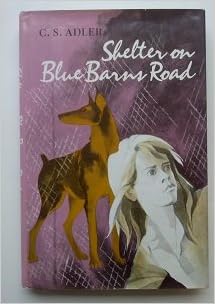Shelter on Blue Barns Road
C.S. Adler
1981, Macmillian Publishing Co.
Lonely and bored after moving from Brooklyn to rural upstate New York, 13-year-old Betsy discovers the local dog pound is near her new home. She wanders in and is caught by the presence of a Doberman Pinscher.
In the center of one cage stood a sleek black, pointy-eared Doberman with brown fur lining his undersides and half circles of brown above his intelligent eyes. Ears at attention, he watched her intently. His dignity impressed her - the way he stood so quietly.
Betsy has an interesting family. Her father is a former teacher, who was fired.
It wasn't Pops's fault. The kids had driven him out of his mind, so he'd shoved a couple around and used bad language.
Her older brother, 17-year-old Hal, is angry at their father for the upheaval he's caused, but Betsy remains loyal. She knows that her once close bond with him has suffered in part because as she's grown older, she reminds him of his students, who he can't control and who taunt him. He was famous in the school as an easy teacher, one whose students push him to see how far they can go. Betsy's mother, who's also frustrated with the man of the house, has gotten a new job here as a guidance counselor. Betsy feels herself a changeling, who looks nothing like the men in her family and, with 2 teacher parents, bad at school. Feeling dumb, feeling unwanted, she gravitates toward the Doberman when she discovers he's also a freak, an unwanted dog surrendered for biting two people.
His owner died, an old lady who had an appliance store a quarter of a mile down the road from here. She used that Doberman to guard the store nights. He even made the paper once. Two guys broke in, and by the time the police got there, they were chewed up so bad that the police had to take them to the hospital instead of jail.
Betsy's also shocked to discover the animal shelter kills unwanted dogs and cats.
An animal shelter! What a laugh that was. "Animal shelter" for a place that killed dogs. She closed her eyes and tried to find a hiding place inside her head, but the horror crept in after her. She wondered if there were other shelters, if all over the country animals were being "put down" because no one wanted them. The idea sickened her. She got up and began pacing around her bedroom, biting on her knuckles. First, she had to save the Doberman. Then she would see what she could do for those others.
Betsy is baffled that the shelter's two employees, manager Mr. Berrier and 16-year-old kennel worker Bill Wing, seem resigned to the killing. They seem nice, yet they kill dogs and they will, eventually, kill the dog called Zoro.
The plot is more than this - it follows Betsy to her new school and through her father's testy relationship with his family and into Bill's reluctant participation in a drug sale - but it centers on Betsy's outrage at the tragedy of death, and her desperate need to help Zoro. She thinks he needs her, which he does, but since that's true of all the dogs in the shelter, her drive to help him specifically is interesting. In one scene halfway through the book, Betsy comes to the shelter to find Bill leading a gentle old dog to the gas chamber. Two new dogs arrived that morning and this dog has to be killed to make space. Betsy could easily have interceded for this dog, which her parents might well have accepted as a pet (they understandably refuse to let her adopt the violent, dangerous Doberman), but she remains silent as Bill kills him. In truth, her desire to help Zoro is not entirely altruistic. She looks at that powerful, self-contained dog and sees a power she lacks, and she covets it.
In the end Betsy loses Zoro. The Doberman attacks and mauls a man, and is killed. She stands over his grave and vows.
Someday, she promised herself, when she was grown and had her own home, she'd find a Doberman puppy, black with brown underneath and ears that stuck straight up. She would raise him to love people and she would name him Zoro.
A young teen who has just spent the book alternating between trying to soothe an anxious, angry father (fired for lashing out inappropriately) and bonding with an anxious, angry dog (sentenced to die for lashing out inappropriately), who sees only logistical reasons why it's bad that Zoro lunges for everyone but her - this girl is now vowing to stay the course and stick a pattern of being drawn to powerful, aggressive individuals. It's a troubling ending, although the author probably intended it to be uplifting or motivating. It is, in a sense. Zoro was raised poorly and developed into a dangerous dog because of that. Raising a Doberman puppy well would probably prevent that outcome. But it's interesting how current this 34-year-old book is in its insistence that the dog, a Doberman, only turned dangerous because of abuse. The Doberman, a breed designed for guard and police work, is innately aggressive and while not every member of the breed is actively dangerous, they pose a much higher risk for aggressive behavior than, say, a Golden Retriever. With some breeds, you would have to really abuse them to create aggressive behavior and even then, a lot wouldn't show violence. With other breeds, creating aggressive behavior is much easier and can be accomplished just by not actively staying on top of the dog's behavior. Dobermans are one of the latter breeds.
Other issues:
The shelter in the book uses a gas chamber to kill dogs. This method is now on its way out, due to concerns about its effectiveness and humaneness. Many states have both abolished it and banned it in favor of intravenous injection. New York, where this book takes place, requires IV euthanasia.
Of course, euthanizing any shelter dog for any reason is now debated. Proponents of "no-kill" claim it's the way of the future and the only humane approach to sheltering. Others express concerns about long-term warehousing of unwanted pets - some dogs at no-kill shelters end up spending their whole lives there, so you'll see ads for "Rex, who's been here since his birth 8 years ago" - and
about the morality of keeping alive physically healthy but dangerously aggressive dogs who can never be rehomed without placing the community at risk. There is also tension as calling your shelter no-kill places a certain inevitable stigma on every other shelter in the area - most of which are supporting you because when a no-kill shelter must turn away unwanted pets due to space, the "kill shelter" has to take them.
Zoro, like most Dobermans in the US, has cropped (stuck straight up) ears. This practice of mutilating and "training" a puppy's ears to increase the sleek, dangerous appearance of various breeds has been banned in Europe, and will probably, eventually, end in the US as well.
 Paperback edition
Links
C.S. Adler's website
Paperback edition
Links
C.S. Adler's website







